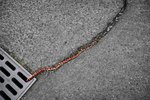
If your snake escapes his enclosure, immediately confirm no windows or doors leading outside are open. If none were open, and your home has absolutely no holes in your walls or floors, your snake is in the house, and he could be hiding just about anywhere. Start with a thorough search of the room where you keep your snake, then radiate outward from there through the rest of the house. If necessary, move on to tricks and traps. Think like a snake, not a human: Look to cozy, dark places.
Step 1
Look behind your snake's habitat, then behind and under all the furniture. Snakes are likely to settle in behind or beneath furniture or objects. Look along all the walls and in and under any baseboard heating elements. Snakes are unlikely to go into toilets but may very well end up behind them or even their tanks. Hand-held mirrors and flashlights are useful tools. Don't forget to pull aside curtains and blinds.
Step 2
Examine upholstered furniture closely for holes in the fabric into which your snake may have slithered. Look between and under cushions, too. Inspect bookshelves and other shelves, including behind items on the shelves.
Step 3
Pay attention to all cabinets. Get on the floor and look at the base of cabinets. Snakes can open cabinet doors, so you have to look inside as well -- though don't expect your snake to shut the door behind him. Check in, under and behind any fixtuers and pipes. Look for holes through which your snake may have crawled. They can get into much smaller spaces than you might expect. Make a mental or written note of these areas so you can fill the holes after your search, just in case of a subsequent escape.
Step 4
Check inside anything hollow with an opening. This includes tissue boxes, containers, bags, shoes, garbage cans, hampers, certain electrical devices and anything else that could possibly serve as a hiding place.
Step 5
Set "alarms" that make noise along the walls at night if your search hasn't turned up your missing pet snake. Crumbled plastic shopping bags work well, but anything you can come up with that will make noise when your snake slithers over it will do. Turn out all the lights, turn off anything that makes noise and sit down in a central location with a flashlight in hand. Have someone doing the same in as many rooms as possible. Wait and listen closely. If you hear a bag disturbed, shine the flashlight at the area and keep it on your snake when you see it. Move softly and quickly.
Step 6
Facilitate tracking by pouring flour across all doorway thresholds and in various places around rooms. Leave them overnight. In the morning, look for disturbed flour, which should show your snake's trails. Even if the flour trails don't lead you to the exact spot your snake is hiding, it should facilitate tracking and greatly narrow down the search.
Step 7
Make a trap using a live or recently dead bait such as a mouse. Place it inside a cage, box or other suitable item the bait can't get out of but that your snake can enter. Keep the area warm to encourage the scent of decay if your bait is dead and also to encourage your snake to remain active. If you have time at night, keep the room very faintly lit and sit still, observing the trap. Otherwise, your snake will likely still be in or right near the trap in the morning, digesting its meal.
References
Tips
- Snakes don't particularly like to move about, especially in daylight. That applies even to diurnal species. So they're likely to be close to their habitat, which is why you should start local, then move on to neighboring rooms and then further away.
- Enlist a search party, if possible, and assign different rooms to different people. The more eyes looking, the more likely you are to find your escaped snake efficiently. If he doesn't turn up, reassign people to different rooms; it's likely multiple sets of eyes will facilitate the discovery of more potential hiding spots in a room; the fresh perspectives should help.
Warnings
- If you also have mice, rats, hamsters or other rodents as pets, secure their cages against any snake intrusions as soon as you notice your missing reptile. Depending on the type and size of the loose snake, take precautions for cats, small dogs, ferrets and other pets, too.
Photo Credits
-
Jupiterimages/Brand X Pictures/Getty Images
Writer Bio
Eric Mohrman has been a freelance writer since 2007, focusing on travel, food and lifestyle stories. His creative writing is also widely published. He lives in Orlando, Florida.




